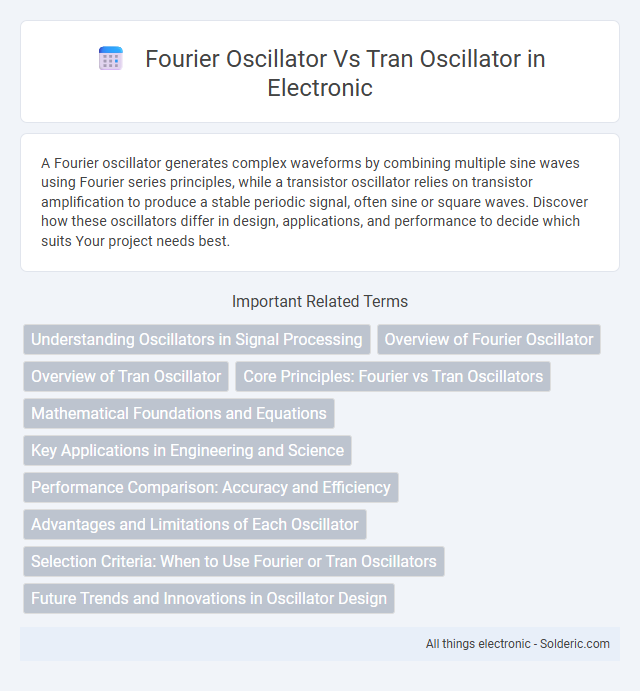A Fourier oscillator generates complex waveforms by combining multiple sine waves using Fourier series principles, while a transistor oscillator relies on transistor amplification to produce a stable periodic signal, often sine or square waves. Discover how these oscillators differ in design, applications, and performance to decide which suits Your project needs best.
Comparison Table
| Feature | Fourier Oscillator | Transistor Oscillator |
|---|---|---|
| Principle | Based on Fourier series decomposition of signals | Uses transistor amplification for sustained oscillations |
| Core Component | Mathematical signal analysis | Transistor (BJT, FET) |
| Application | Signal analysis, harmonic synthesis | Signal generation, RF circuits, audio oscillations |
| Output Signal | Decomposed frequency components | Continuous waveform (sine, square, triangle) |
| Energy Source | External signal input | DC power supply |
| Frequency Control | Mathematical adjustment via Fourier coefficients | Tuned circuit components (LC, RC networks) |
| Complexity | High, theoretical signal analysis | Moderate, practical electronic design |
Understanding Oscillators in Signal Processing
Fourier oscillators generate periodic signals using sinusoidal components based on Fourier series principles, ideal for synthesizing complex waveforms with precise frequency control. Transistor oscillators rely on electronic components, such as bipolar junction transistors or field-effect transistors, to create sustained oscillations through positive feedback loops, commonly used in radio frequency applications. Understanding these oscillators' operational differences enhances signal processing tasks by optimizing waveform generation, frequency stability, and application-specific performance.
Overview of Fourier Oscillator
A Fourier oscillator generates sinusoidal signals by using multiple harmonics to approximate waveforms, enabling precise frequency synthesis and harmonic control. This contrasts with a traditional transistor (Tran) oscillator, which typically relies on feedback in a single resonant circuit to produce a fundamental frequency. Understanding the Fourier oscillator's approach can enhance Your ability to design circuits requiring accurate harmonic content and waveform shaping.
Overview of Tran Oscillator
Tran Oscillators generate continuous sinusoidal signals by employing a transistor-based feedback loop for stable oscillation. They offer advantages such as simpler circuit design and ease of integration in low-frequency applications compared to Fourier Oscillators. Your choice between Tran Oscillators and Fourier Oscillators depends on frequency stability needs and circuit complexity preferences.
Core Principles: Fourier vs Tran Oscillators
Fourier oscillators leverage Fourier series to generate complex waveforms by summing multiple sine and cosine components, enabling precise frequency synthesis with harmonic control. Tran oscillators, based on transient response of active devices, utilize switchable feedback paths to produce sharp pulses and frequency modulation more efficiently for digital signal applications. The core distinction lies in Fourier oscillators' frequency domain synthesis versus Tran oscillators' time domain transient manipulation for waveform shaping.
Mathematical Foundations and Equations
The Fourier oscillator relies on Fourier series to generate signals by decomposing periodic waveforms into sums of sinusoids, represented mathematically as \( x(t) = \sum_{n=-\infty}^{\infty} c_n e^{j n \omega_0 t} \), where \( c_n \) are Fourier coefficients. The Tran oscillator, often associated with transient or relaxation oscillators, uses differential equations describing charge and discharge cycles, typically modeled by \( \frac{dV}{dt} = \frac{1}{RC}(V_{supply} - V) \) for voltage changes in RC circuits. Fourier oscillators emphasize frequency domain analysis through harmonic components, whereas Tran oscillators focus on time-domain responses and state transitions governed by first-order differential equations.
Key Applications in Engineering and Science
Fourier oscillators are primarily used in signal processing and communication systems to generate precise frequency waveforms ideal for spectral analysis and synthesis. Transistor oscillators find key applications in electronic circuits for radio frequency generation, amplification, and timing in devices such as oscillators in radios, clocks, and embedded systems. Your choice between these oscillators depends on the specific engineering or scientific task, where Fourier oscillators excel in frequency domain applications while transistor oscillators are preferred for practical electronic implementations.
Performance Comparison: Accuracy and Efficiency
Fourier oscillators provide higher accuracy in frequency synthesis due to their direct harmonic generation and superior phase noise characteristics compared to traditional transistor (Tran) oscillators. Tran oscillators often consume less power and exhibit simpler circuit designs, enhancing efficiency but at the cost of lower spectral purity and increased distortion. In applications demanding precise signal generation, Fourier oscillators outperform Tran oscillators in accuracy, while Tran oscillators excel in power efficiency and ease of implementation.
Advantages and Limitations of Each Oscillator
The Fourier oscillator excels at generating precise sinusoidal waveforms with high frequency stability, making it ideal for signal processing applications; however, it often requires complex circuitry and higher power consumption. The Tran oscillator offers simpler design and lower power usage suitable for integrated circuit implementation but may suffer from phase noise and limited frequency accuracy compared to the Fourier oscillator. Each oscillator's suitability depends on the trade-off between waveform purity, power efficiency, and circuit complexity in specific electronic applications.
Selection Criteria: When to Use Fourier or Tran Oscillators
Fourier oscillators excel in generating pure sinusoidal signals with precise frequency control, making them ideal for applications requiring stable, low-distortion waveforms such as communication systems and signal processing. Tran oscillators are preferable when you need simple, low-cost, and easily tunable oscillations in applications like audio tone generation and basic timing circuits. Your choice depends on whether frequency stability and waveform purity (Fourier oscillator) or simplicity and cost-effectiveness (Tran oscillator) are the priority.
Future Trends and Innovations in Oscillator Design
Future trends in oscillator design emphasize enhanced frequency stability, reduced phase noise, and integration of wideband tuning capabilities, with Fourier oscillators advancing through digital signal processing techniques for improved harmonic control. Transistor-based oscillators benefit from innovations in semiconductor materials like GaN and SiC, enabling higher power efficiency and operation at millimeter-wave frequencies critical for 5G and beyond. Emerging designs also focus on miniaturization using MEMS technology and AI-driven adaptive frequency calibration, pushing oscillator performance boundaries across telecommunications and sensing applications.
fourier oscillator vs tran oscillator Infographic

 solderic.com
solderic.com